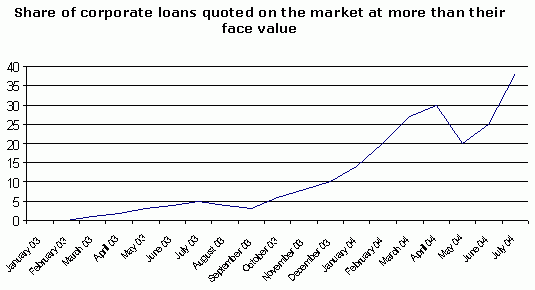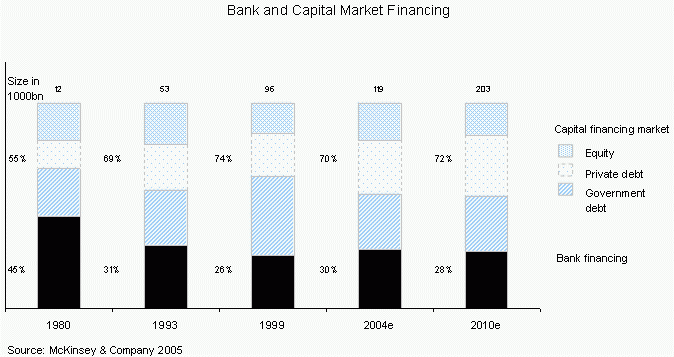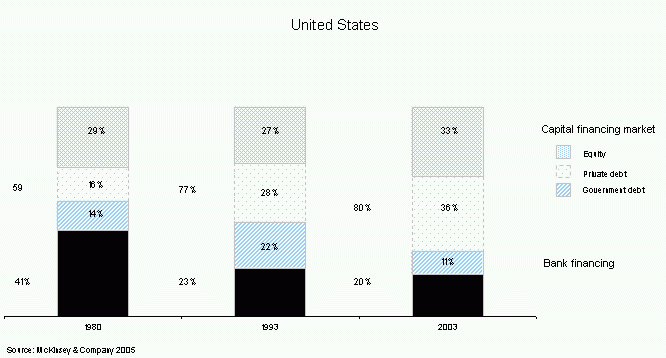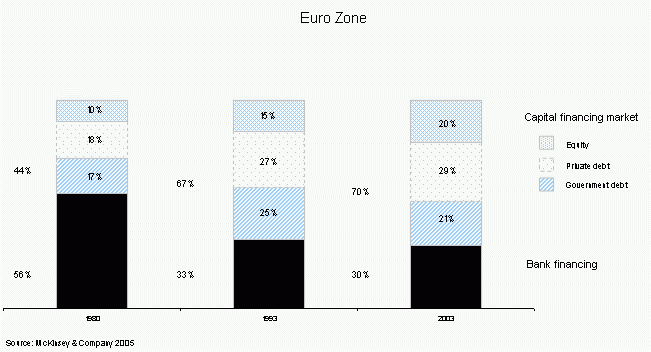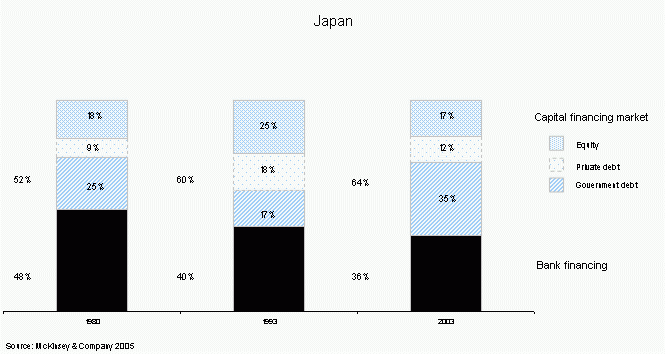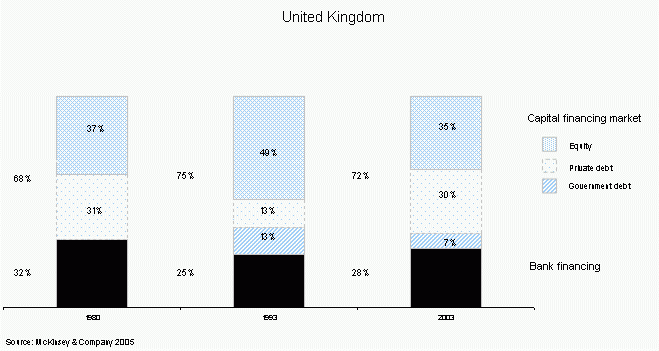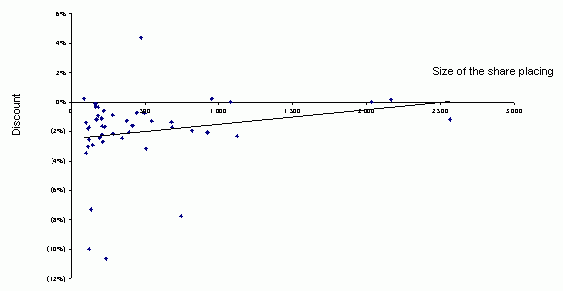Letter number 7 of June 2005
- TOPIC
- STATISTICS
- RESEARCH
- QUESTIONS & COMMENTS
News : When valuing shareholders’ equity, should debt be taken at fair value?
Analysts practically always take the amount on the balance sheet as the value of debt. This very convenient simplification has until now had no impact on the result of the calculation (except for companies on the verge of bankruptcy), since the amount on the balance sheet corresponded to the value of the company’s bank and other financial debt.
The choice between taking the fair value or the book value of debt, which until now was a relatively theoretical decision, today seems to have taken on a concrete dimension for a number of groups whose creditworthiness is improving (Ericsson debt is once more rated as investment grade, Ford’s and General Motor’s are no longer). This is reinforced by a situation where the cost of debt is falling as a result of falling margins (spreads), which could be followed in the near future by a rise in interest rates. In short, the period during which companies benefited from stable borrowing costs could be drawing to a close, which also means an end to stability in the value of their debt.
In the USA, the share of corporate loans quoted on the market at more than their face value rose by 10% at the start of the year to more than one-third today:
Firstly, what are the circumstances in which we observe a difference between the value of a debt and its book value? We have identified three:
- When the company borrowed at a fixed rate (directly or following a swap (2)) and there was a subsequent change in interest rates,
- When there has been a substantial change in a company’s creditworthiness (either up or down) since the debt was lifted without an readjustment of the interest margin paid,
- When the face value of the debt has been artificially reduced by adding subscription warrants or other detachable products after the issue of the bonds.
Take two companies which each borrowed 100 at the variable 5-year government bond rate +1% in 2000. The first swapped its debt for a 7% fixed rate loan. The other stayed on the variable rate. Today, although the return on the government bond is around 4%, the first has a debt that costs 7% and the second 5%.
Clearly, there is a difference here, and the shareholders of the first company are worse off than those of the second. Direct valuation methods (discounting dividends or cash flow to equity, P/E ratio) will highlight this, since financial charges are integrated into the calculation. On the other hand, using indirect methods (discounting free cash flows, NOPAT multiples), the only way to take this different reality into account is to take the debt at its fair value rather than its book value. The first company’s debt, factoring in the swap, is worth more than its face value since it continues to earn 7% in a context where the interest rate is 5%.
We’d also advise you, when the debt is large and the difference between the value of the debt and its book value is too, to think in terms of fair value and not in terms of book value.
An examination of France Telecom’s annual report shows that this was not an issue in 2002 (long term debt of €60.4bn in book value and €62.1bn at fair value) but it arose in 2003 and its 2004 thanks to the improvement of the group’s creditworthiness. On 31 December 2004, the book value of long term debt was €43.5bn, but the fair value was €48.0bn, a difference of €4.5bn, or 8% of France Telecom’s market capitalisation. Ignoring this difference amounts to taking a risk of, in this case, being out by 8%.
Failing to use this approach when there is a difference between the fair value and the market value of a debt, amounts to internal inconsistency. In fact, when calculating the weighted average cost of capital, the interest rate used is the company’s present interest rate (5% in our initial example) and not the historic interest rate (7%).
The 5% rate cannot apply to the book value of the debt (100 for example with an annual coupon of 7), but only to its fair value (140 if the debt is perpetual, to simplify the mental arithmetic) since it is a present rate and not an historic one.
In fact, 5% of 140 does equal 7 (100 x7%) which is effectively paid, while 5% of 100 is only equal to 5, a figure which differs from reality.
Does this approach work against the interests of shareholders, as is sometimes said? No, since the increase in the value of the debt resulting from an improvement in the company’s creditworthiness, only reduces the value of equity in simplistic and false models.
Better creditworthiness is not a rabbit that can be pulled out of a hat. If the financial structure is constant, it is the result of better operating performances which lead to a better valuation of capital employed, which in turn means an increase in the value of equity. The example of France Telecom since late 2002 provides a good illustration of this global mechanism, since although the value of its debt increased by 8%, the value of its shares rose by a lot more: + 33%.
(2) For more information, see chapter 48 of the Vernimmen.
Statistics : $ 119,000,000,000,000
A highly interesting study by McKinsey (1), the result of some very hard work, shows that at an international level, a shift from a debt-based economy to a capital market economy took place in the early 1990s.
Remember that in a debt-based economy (2), capital markets are very rarely tapped. Accordingly, only a small portion of companies’ financing requirements are covered by the issue of securities. A debt-based economy is an economy in which most companies’ financing needs are covered by credit extended by banks. Companies borrow heavily from banks, whose refinancing needs are covered by the central bank.
In a capital market economy (2), companies cover most of their financing needs by issuing financial securities (shares, bonds, commercial paper, etc.) directly to investors. A capital market economy is characterised by direct solicitation of investors’ funds. Many economic agents with surplus capital invest a large portion of their funds directly in the capital markets by buying companies’ shares, bonds, commercial paper or other short-term negotiable debt, either directly or through mutual funds. Intermediation gives way to the brokerage function, and the business model of financial institutions evolves towards the placement of securities issued by companies directly with investors.
The share of bank financing stabilises at around 30% and the share of capital market financing at around 70%. But obviously, these global figures conceal strong regional disparities, since in the USA, the share of bank financing is only 20%, compared with 30% in the euro zone and 36% in Japan.
(2) For more information see chapter 15 of the Vernimmen.
Research : Corporate Finance in Europe: confronting theory with practice
These differences have major repercussions in terms of corporate governance, and ultimately, on the development of financial markets in these countries. They are also likely to have significant repercussions on the financial practices of companies in Europe and the in USA. A team of Dutch researchers (1) carried out a study on a sample of European companies, seeking to add to an American study (2) which summary is available on Vernimmen.com.
The results they obtain on a sample of 313 responses returned by the Finance Directors of UK, Dutch, German and French companies confirm our received ideas of how corporate finance is practised. The main results of the research are discussed below.
The authors noted that the European companies that responded to their survey did not all have the same goals, with goals differing from country to country. The British and Dutch companies all gave great importance to shareholder value as a decision-making criterion, while far fewer French and German companies saw shareholder value in this light.
The favourite investment decision-making criterion of the majority of European Finance Directors is the pay-back criterion (3). This criterion does not factor in the time value of cash flows or cash flows after the date on which the investment is recovered. In the USA, the payback criterion was only ranked third, behind IRR (internal rate of return) and NPV (net present value). The dominance of this investment decision-making criterion in Europe is more pronounced in smaller companies, in companies with older senior managers who have not done MBAs, and in unlisted companies.
Among the companies basing their investment decision-making on NPV criteria, European companies mainly use the CAPM (capital asset pricing model) for calculating the cost of capital, although not quite as often as their US counterparts. Here again, large companies and listed companies rely on this method more often than other companies.
European companies, like their US counterparts, rarely consider risk factors that are specific to the investment projects in question, such as interest rate risk, foreign exchange risk, etc. Only French companies, and to a lesser degree German ones, say that they adjust the discounted cash flow rate to recent stock market performances and to the risk of fluctuations in the price of raw materials. Finally, European companies only make minor adjustments to the cost of capital required for international projects, which goes against the theory and against common sense (5).
The authors also looked at choices of capital structure (debt to equity ratio) made by the Financial Directors of European Companies. They looked at the relevance of the two main theories on which decisions relating to capital structure are based. The first is the static trade-off theory (6) , which postulates that each company has a target capital structure which depends on tax advantages relating to debt and bankruptcy costs. The second is the pecking order theory (7) which postulates that as a result of information asymmetry between managers and the capital markets, companies have an order of preference for the various sources of capital for financing their investment projects. Internal resources are preferable to debt, which in turn is preferable to equity.
European companies, and especially French and British companies, would appear to set an optimal target capital structure slightly more frequently than their US counterparts. Furthermore, the criteria generally relied on for setting a target capital structure (debt-related tax breaks, bankruptcy costs) would not appear to have such a tangible influence on determining the optimal capital structure in the USA. The results obtained provide only a little support for the trade-off theory in Europe.
The pecking order theory would appear to be rejected in Europe, in the same way that the US study showed it was in the USA. The behaviour of European Finance Directors reveals a preference for internal sources of financing relative to debt and equity.
The underlying motivation for this behaviour is not linked to information asymmetry between managers and capital markets, but the determination to hold onto the company’s flexibility and its ability to finance its investments autonomously. This should not come as much of a surprise to our readers.
More or less stating the obvious, the authors show that the larger the companies, the greater their preoccupation with the creation of shareholder value, and the more they will rely on sophisticated methods for their investment decision-making, aware that arguments in favour of a choice of financial structure based on tax considerations have never been very convincing.
(2) Graham, J.R. Campbell, Harvey. 2001. “The Theory and Practice of Corporate Finance: Evidence From the Field”, Journal of Financial Economics, pages 187 to 243.
(3) See chapter 20 of the Vernimmen.
(5) See chapter 23 of the Vernimmen.
(6) See chapter 34 of the Vernimmen.
(7) See chapter 36 of the Vernimmen.
Q&A : How does one go about selling a block of shares in a listed company?
What the seller can do is ask a (or several) bank(s) to place these shares with investors. There are two possible options:
1. Bookbuilding and accelerated bookbuilding
A block trade is done via bookbuilding (1). Block trades are however “simpler” deals than capital increases and require less marketing. Accelerated bookbuilding is faster, top management is less involved and sometimes not involved at all, and the whole deal can sometimes be done in a few hours.
Bigger transactions involving a strategic shift (exit of a controlling shareholder, etc.), may require an intense marketing campaign involving management.
2. Bought deals and block trades with a back-stop
When the seller initiates a bookbuilding or accelerated bookbuilding process, he has no guarantee that the transaction will go through. Nor does he know at what price the deal will be done. To solve this problem, he can ask the bank to buy the shares itself. The bank will then place them with investors. This is called a bought deal.
The bank will be taking a significant risk and will, theoretically, only buy the shares at a discount to the market price.
The advantage of a bought deal is that the seller knows that the deal will go through and also exactly how much he will get when he decides to sell. There are some disadvantages, however:
The deal will generally be at a greater discount than for an accelerated bookbuilding
Share performance can suffer, as the bank that has acquired the shares will want to sell them as quickly as possible, even if that means causing a fall in the share price
The block trades market has now become so competitive for banks that companies are able to have their cake and eat it – bookbuilding is done but the bank(s) placing the shares guarantee a minimum or backstop price for the placement. If all of the shares are not sold at this price when the placement closes, the bank is bound to buy the shares that have not been placed at the stated price.
Banks are becoming increasingly aggressive on these sorts of deals, with the main aim being to grab the largest market share of credentials rather than to make money. The graph below (block trades worth more than €100m placed since the start of 2003) shows that the larger the block, the lower the discount, although we’d have expected the opposite to be true!
There have been cases of banks doing bought deals at a price that is higher than the reference price. This results in a premium and not a discount. An example of such a situation was the sale of a block of Thomson shares by the French government. This extremely risky decision is taken by banks after the markets close. They are able to see what the shares are doing on the US market when the European markets are closed due to the time difference.
In late 2004 and early 2005, a number of large deals resulted in major losses for some of the big investment banks – reclassification of TeliaSonera share by Finnish government and of the Atos Origin share by Philips.
